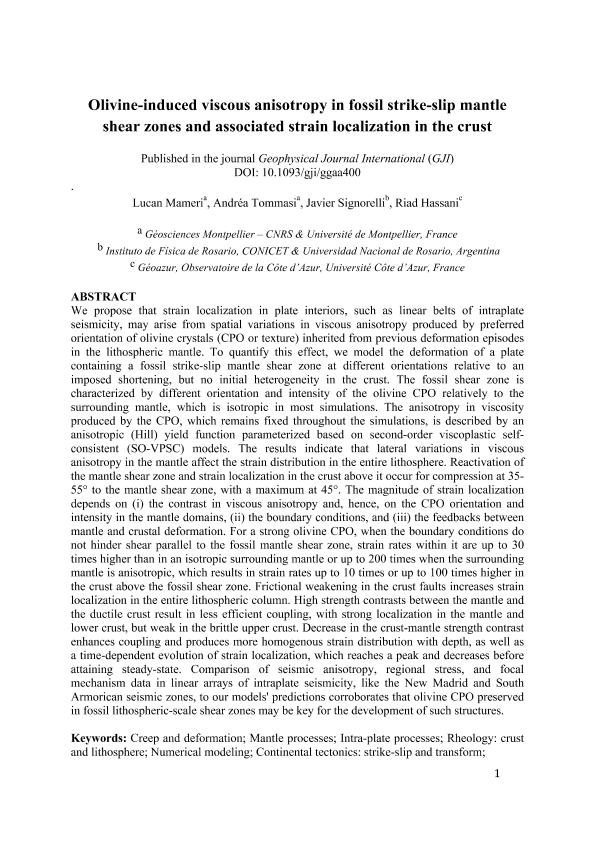Mostrar el registro sencillo del ítem
dc.contributor.author
Mameri, Lucan

dc.contributor.author
Tommasi, Andrea

dc.contributor.author
Signorelli, Javier Walter

dc.contributor.author
Hassani, Riad

dc.date.available
2021-10-18T18:54:37Z
dc.date.issued
2021-01
dc.identifier.citation
Mameri, Lucan; Tommasi, Andrea; Signorelli, Javier Walter; Hassani, Riad; Oliine-induced iscous anisotropy in fossil strike-slip mantle shear zones and associated strain localization in the crust; Wiley Blackwell Publishing, Inc; Geophysical Journal International; 224; 1; 1-2021; 608-625
dc.identifier.issn
0956-540X
dc.identifier.uri
http://hdl.handle.net/11336/144151
dc.description.abstract
We propose that strain localization in plate interiors, such as linear belts of intraplate seismicity, may arise from spatial ariations in iscous anisotropy produced by preferred orientation of oliine crystals (CPO or texture) inherited from preious deformation episodes in the lithospheric mantle. To quantify this effect, we model the deformation of a plate containing a fossil strike-slip mantle shear zone at different orientations relatie to an imposed horizontal shortening, but no initial heterogeneity in the crust. The fossil shear zone is characterized by different orientation and intensity of the oliine CPO relatiely to the surrounding mantle, which is isotropic in most simulations. The anisotropy in iscosity produced by the CPO, which remains fixed throughout the simulations, is described by an anisotropic (Hill) yield function parametrized based on second-order iscoplastic self-consistent (SO-PSC) models. The results indicate that lateral ariations in iscous anisotropy in the mantle affect the strain distribution in the entire lithosphere. Reactiation of the strike-slip mantle shear zone and strain localization in the crust aboe it occur for horizontal compression at 35-55? to the fossil shear plane, with a maximum at 45?. The magnitude of strain localization depends on (i) the contrast in iscous anisotropy and, hence, on the ariations in CPO orientation and intensity in the mantle, (ii) the boundary conditions and (iii) the feedbacks between mantle and crustal deformation. For a strong oliine CPO, when the boundary conditions do not hinder shear parallel to the fossil mantle shear zone, strain rates within it are up to a factor 30 higher than in an isotropic surrounding mantle or up to a factor 200 when the surrounding mantle is anisotropic, which results in strain rates up to a factor 10 or up to a factor 100 higher in the crust right aboe the fossil shear zone. Frictional weakening in the crust faults increases strain localization in the entire lithospheric column. High strength contrasts between the mantle and the ductile crust result in less efficient mechanical coupling, with strong localization in the mantle and lower crust, but weak in the brittle upper crust. Decrease in the crust-mantle strength contrast enhances the coupling and produces more homogenous strain distribution with depth, as well as a time-dependent eolution of strain localization, which reaches a peak and decreases before attaining steady-state. Comparison of seismic anisotropy, regional stress and focal mechanism data in linear arrays of intraplate seismicity, like the New Madrid and South Armorican seismic zones, to our models' predictions corroborates that oliine CPO presered in fossil lithospheric-scale shear zones may be key for the deelopment of such structures.
dc.format
application/pdf
dc.language.iso
eng
dc.publisher
Wiley Blackwell Publishing, Inc

dc.rights
info:eu-repo/semantics/openAccess
dc.rights.uri
https://creativecommons.org/licenses/by-nc-nd/2.5/ar/
dc.subject
CONTINENTAL TECTONICS: STRIKE-SLIP AND TRANSFORM
dc.subject
CREEP AND DEFORMATION
dc.subject
INTRA-PLATE PROCESSES
dc.subject
MANTLE PROCESSES
dc.subject
NUMERICAL MODELING
dc.subject
RHEOLOGY: CRUST AND LITHOSPHERE.
dc.subject.classification
Ingeniería de los Materiales

dc.subject.classification
Ingeniería de los Materiales

dc.subject.classification
INGENIERÍAS Y TECNOLOGÍAS

dc.title
Oliine-induced iscous anisotropy in fossil strike-slip mantle shear zones and associated strain localization in the crust
dc.type
info:eu-repo/semantics/article
dc.type
info:ar-repo/semantics/artículo
dc.type
info:eu-repo/semantics/publishedVersion
dc.date.updated
2021-09-06T21:02:14Z
dc.journal.volume
224
dc.journal.number
1
dc.journal.pagination
608-625
dc.journal.pais
Reino Unido

dc.journal.ciudad
Londres
dc.description.fil
Fil: Mameri, Lucan. Université de Montpellier; Francia. Centre National de la Recherche Scientifique; Francia
dc.description.fil
Fil: Tommasi, Andrea. Université de Montpellier; Francia. Centre National de la Recherche Scientifique; Francia
dc.description.fil
Fil: Signorelli, Javier Walter. Consejo Nacional de Investigaciones Científicas y Técnicas. Centro Científico Tecnológico Conicet - Rosario. Instituto de Física de Rosario. Universidad Nacional de Rosario. Instituto de Física de Rosario; Argentina
dc.description.fil
Fil: Hassani, Riad. Observatoire de la Cote D'Azur; Francia. Université Côte d'Azur; Francia
dc.journal.title
Geophysical Journal International

dc.relation.alternativeid
info:eu-repo/semantics/altIdentifier/url/https://academic.oup.com/gji/advance-article/doi/10.1093/gji/ggaa400/5896955
dc.relation.alternativeid
info:eu-repo/semantics/altIdentifier/doi/http://dx.doi.org/10.1093/gji/ggaa400
Archivos asociados
